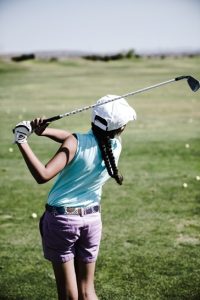GOLFING INJURIES AND PREVENTION TIPS
Golf is one of the most popular sports across the UK, and with it being one of the only sports allowed in Phases 1 & 2 of our way out of Lockdown, its popularity will no doubt be on the rise. There are an estimated 1.5 million adult golfers in the UK who participate at least once a week. With the accessibility and participation growing and the ability of golfer’s careers to span decades, an increase in prevalence is to be expected.
In this article we highlight some common injuries and risk factors associated with golf, and offer some tips and advice on how to reduce the likelihood of these injuries, or manage your injury better.

Common Golfing Injuries
- LOWER BACK
This is the most common injury in amateur golfers (2nd most common in professionals) and accounts for 20-40% of all golfing injuries. Studies have shown that the area at risk tends to be on the right side if right handed golfer and vice versa if left handed.
It is thought that older golfers may be more susceptible to back injury or discomfort when playing due to reduced mobility of the spine as we age, and a reduced ability to produce and absorb forces in the trunk/spine.
- ELBOW
Elbow injuries account for up to 33% of golfing injuries, with studies suggest they are the second most common injury in amateur golfers. Most of us will be familiar with the term “Golfer’s Elbow” (or medial epicondylitis) which is caused by irritation of the tendons on the inside of the elbow. This issue is usually caused by hitting a “fat shot” and the trail arm is typically more at risk.
Ironically lateral elbow pain (or “Tennis Elbow”) is a more common complaint with amateur golfers. This irritation of the tendons on the outer part of the elbow usually occurs on the lead arm and is most likely down to over-practice, over-gripping the club or changes to grip due to fatigue during practice.
- SHOULDER
Shoulder injuries account for up to 19% of golfing injuries. Golf is a unique sport in regards to the shoulders as each shoulder has to do very different movements. Injuries tend to occur more in the lead arm as it is forced into extreme movements at the end of the backswing. Whilst shoulder injuries are common, they tend to respond well to a period of rehabilitation and subtle modifications of the golf swing.
Common issues seen in the shoulder include impingement, rotator cuff tears and acromioclavicular joint (ACJ) pain.
- WRIST/HAND
Wrist and hand injuries are thought to account for 13-20% of all injuries in amateurs, but may be higher in professionals. During the golf swing the wrist/hand is the anchor point between club and the body therefore must tolerate a large amount of force and range of motion with every swing. Injuries usually occur when the club comes into contact with an object other than the ball (e.g. a root of a tree) which causes a sudden deceleration and increase load. Trauma to the muscles, tendons and bones of the hand and wrist can occur from one “fat shot” (similar to elbow injuries) or micro-trauma may build up over a series of rounds.
Causes of Injury and Risk Factors
Like any sport, an acute injury can occur from unexpected or unplanned movements such as hitting the ground on a shot or rolling your ankle on an uneven part of the course. However, generally amateur golfers are prone to injury from poor physical condition and swing mechanics, while professionals are more at risk from overuse.
The mechanisms of injury for amateur golfers are varied and multifactorial and could include some of the following:
- Overuse
We know overuse is a major cause of injury in professionals however golf enthusiasts may also be guilty of overtraining – this could be simply be repetitive shot practice or playing on many consecutive days without adequate rest. One study has shown that those who spend more than 6 hours per week in competitive play are more at risk of injury. Another study showed more than 4 rounds per week or 200 + balls could increase injury risk.
- Trauma/hitting ground
As mentioned previously, hitting a “fat shot” causes a rapid unexpected deceleration of force and can be a cause of many wrist and hand injuries in the golfing population.
- Swing Faults
The golf swing is a complex and co-ordinated movement involving the whole body. When the swing is repeated frequently it can put stress on bones, ligaments and muscles. If any aspect of the movement is sub-optimal it may increase your risk of injury.
Some common faults with swing mechanics include
- Over-swinging
- Chicken wing
- Poor address posture
- Other technical faults such as grip pressure, over the top and early extension
- Inadequate Warm Up
Warming up for any sport is a key element for injury prevention. With the complexity of movements, speeds and forces involved in the golf swing, there is clearly a physiological basis to warm up the muscles, tendons and ligaments which will be required to produce the forces necessary.
Despite there being an understanding of the importance of warming up, only around half of amateur golfers do any sort of warm up, and of that many view a few practice shots before teeing off as adequate.
To read more about the benefits of warming up for golf and some ideas for doing so see our separate blog and video series
- Poor Physical Condition & Previous Injuries
Any muscle weakness particularly around your core (e.g. abdominals, glutes) and shoulders means they are less able to stabilise the body or produce the forces required for the golf swing. Compensations can occur by using other muscles or adapting the swing which can lead to pain and ultimately injury.
A previous injury or incomplete healing of a recent injury may lead to mechanical inefficiency in the swing caused by compensatory muscle activation, stiffness in a particular area or guarding from that injury. This can again lead to recurrence of an old injury or new issues developing.
Injury Prevention/Reduction Tips
As with any sporting activity, there are always some measures that can be taken to help reduce the risk of injury. Here are our top tips to help mitigate the injury risk associated with golf:
- Invest in equipment that is suitable for you
Equipment that is fitted to suit your needs can help prevent injury and lower the risk of recurrent injury – it can also improve your game.
Invest in clubs that are the right length, weight, flex and grip to help prevent injury and increase your enjoyment of the game. Your local PGA professional is the best person to contact for this.
If you carry your golf clubs consider cutting down the number of clubs you are carrying and ensure you use double straps to spread the load evenly across your back. This will help to reduce the stresses and strains in your back and shoulders. It may also be worth clearing out your golf bag to ensure you are not carrying any unnecessary golf balls etc. which may be inadvertently adding to your load.
Golf shoes can provide support during not only the swing but also around the often uneven terrain of a course. They may help prevent slips and trips particularly in wet weather. Make sure your grip is performing on the course – it may only take a few new studs to give you that extra grip.
- Warm up effectively and adequately
For amateurs this is one of the single most effective ways to help reduce injury risk. A good warm up should include general cardiovascular exercises to raise the heart rate, dynamic stretching or mobility work for the spine, arms and legs, and practice swings/shots.
An effective warm up should take 10-20 minutes with a study showing that those who completed a warm up of over 10minutes reduced the injury rate by 50%.
Click here to see some ideas for warming up #### another link to warm up golf videos #####
- Play consistently but avoid overtraining
Like any sport, if you have not played golf for a while it may take your body a while to adapt to the different demands required. This may be particularly true after a prolonged period of inactivity such as lockdown.
Ensure you build up your tolerance over a period of a few weeks and avoid the urge to refine your golf swing with hours of repetitive practice.
Muscles, tendons and bones do not like to be either under loaded or overloaded so finding a consistency with your playing routine whether that is once a week or 2-3 times per week is likely to keep your musculoskeletal system happier.
- Work on your Strength and Flexibility
Gaining strength will not only improve your performance, but can help reduce your risk of injury by developing endurance, power and stability in the shoulder, trunk and legs.
One study showed an improvement of strength and flexibility of up to 40% when mobility and strength work were included. A more recent study concluded that strength training reduced sports injury by a third and estimated that overuse injuries could be reduced by half.
- Learn from a Golf Professional
We now know that poor swing mechanics are a risk factor for injury. A golf professional will be able to analyse your swing, give advice about the right equipment for you and sometimes even “screen” you for flexibility and strength. Most golf courses have a professional who can help.
What if I am injured?
Whether you are suffering from an acute traumatic injury such as rolling your ankle on the green, or a persistent ache in your back or shoulder it is important not to ignore it and play on.
Some soft tissue injuries respond well to ice, rest and some targeted exercises and will resolve quickly if managed well. For longer lasting niggles there may be an underlying cause which needs addressed. Get in contact with a healthcare professional if your symptoms are stopping you golfing or have not resolved within a few weeks.
Physioflex have both physiotherapy and sport injury appointments available, to book online click here or call 01506237770.
